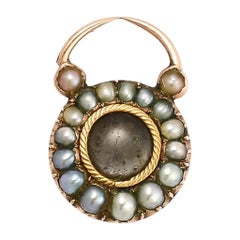Padlock 18th Century
Recent Sales
Antique Early 18th Century English Georgian Pendant Necklaces
Pearl, 9k Gold
Padlock 18th Century For Sale on 1stDibs
How Much is a Padlock 18th Century?
A Close Look at georgian Jewelry
Georgian jewelry is named for the monarchies of the four King Georges, who in succession ruled England starting in 1714 (plus King William’s reign, which lasted until 1837). A slew of beautiful pieces were produced during the period, and today antique Georgian rings, necklaces and other accessories are coveted by fine jewelry collectors.
There are certain features that distinguish jewelry from this era, including the fact that pieces from the 18th and early 19th centuries were handmade (so don’t let the absence of a maker’s mark lead you to believe otherwise). Antique Georgian jewelry also has a certain “look.” It’s a bit gray because stones were often set in silver, and because stonecutting techniques were not as advanced as they are today, the gems do not possess the level of sparkle to which we have become accustomed.
Intricate metalworking techniques such as repoussé (the hammering of metal into ornate designs) and cannetille (a method of working the gold wire to make it look woven) allowed goldsmiths to really flex their muscles. These gold pieces, either on their own or combined with gemstones, made for highly original and dramatic jewelry. The era also saw pieces with ornately woven strands of human hair.
Pearls, along with colored gemstones like garnets, rubies and sapphires, were widely used in Georgian jewelry. These were often cut in the shape of a cabochon or teardrop. It was fashionable to combine garnets or rubies with seed pearls. In Georgian diamond rings, popular cuts for diamonds included rose, old mine and table. Around the 1780s, paste jewelry, or hand-cut glass on foil, was used to imitate diamonds.
Browse a collection of antique Georgian diamond rings, earrings, brooches and other authentic Georgian jewelry today on 1stDibs.
Finding the Right pendant-necklaces for You
Whether you’re layering multiple jewelry pieces or opting for a single strand, vintage pendant necklaces are versatile accessories that can elevate your casual wear as easily as they can add a creative flourish to your formal attire.
The earliest jewelry was less about accessorizing than it was about wearers arming themselves with amulets. In Ancient Egypt, some amulets featured a loop so that they could be strung around one’s neck. While rubies have long been one of the few gemstones that can give diamonds a run for their money, members of some ancient civilizations valued the stones from the get-go, donning ruby pendants as well as other stones with the belief that these adornments would bring protection, healing powers or strength. Today, we still wear our charm bracelets and charm pendants around our necks for good luck.
Later, pendant necklaces, like most fine jewelry, were worn strictly by royalty or the upper class and conferred wealth and prestige. This changed over time, thankfully, as wearing jewelry became more widespread, a democratized means of personal expression.
During the 18th and 19th centuries, pendant necklaces evolved from their status as spiritual amulets, but the jewels still carried deep personal significance. Victorian pendants, in particular, were part of the “mourning jewelry” tradition. Wearers would embed their pendants with locks of hair from a deceased loved one as a way of grieving in the wake of a loss. In the case of cameo jewelry, some pendants were even decorated with miniature hand-carved portraits in a detailed raised relief. Today, portraiture is still a characteristic of many of the hand-carved pendant necklaces offered by Italian jewelry house Scala Gioielli.
Luxury fine jewelry brands such as Cartier, BVLGARI and David Yurman offer their own unique interpretations of the cherished accessory, embellishing platinum or gold pendant necklaces with diamonds, sapphires and other stones.
On 1stDibs, find an extraordinary range of vintage pendant necklaces and other necklaces today.
